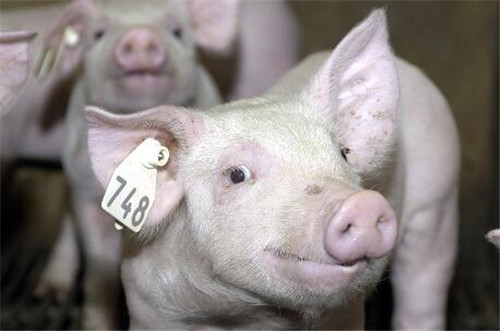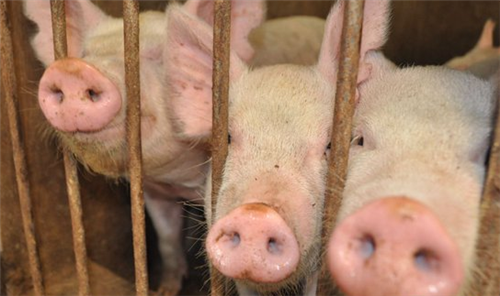What are the trace elements harmful to pigs? What is the performance after poisoning?
As we all know, there are seven kinds of nutrients necessary for the body to maintain its metabolism, namely, water, carbohydrates, proteins, lipids, vitamins, minerals and dietary fiber.
There are mainly 21 kinds of essential mineral elements for animals, accounting for more than 0.01% of the body weight, including 7 kinds of calcium, phosphorus, sodium, potassium, magnesium, sulfur, chlorine and so on. There are about 70 kinds of trace elements that account for less than 0.01% of the body weight. In 1973, World Health Organization (WHO) announced that 14 kinds of iron, zinc, copper, manganese, iodine, selenium, cobalt, molybdenum, chromium, nickel, vanadium, fluorine, silicon and tin were essential trace elements.
The content of essential trace elements in the body is very small, but the biological role is powerful, participate in the metabolism of enzymes, hormones, vitamins and nucleic acids, deficiency will cause serious nutritional and metabolic diseases, and once excessive, it will show toxic reactions.
For example, pigs contain 20 micrograms of selenium per kilogram of body weight, and 0.1 to 0.3 milligrams of available selenium should be provided per kilogram diet, depending on the size of pigs.
Selenium deficiency can lead to nutritional liver necrosis in pigs (brown body fat, subcutaneous edema) and leukomyopathy (muscle fibers pale, swollen, white stripes on the muscle surface); excessive selenium poisoning can lead to animal stumbling blindness (blindness, abdominal pain, salivation, muscle paralysis) and chronic alkalosis (hair loss, foot cleft, long bone and joint erosion, lameness, heart atrophy, liver cirrhosis, anemia), etc.
In addition to essential trace elements, there are some harmful trace elements that are not needed for growth and development in pigs, but harmful trace elements in diets that can not be removed because of environmental pollution can not only accumulate in pigs and cause damage to pigs themselves. it can also be transmitted through the food chain, causing damage to the human body.
Common harmful trace elements are lead, cadmium, mercury, arsenic, thallium, antimony, tellurium and so on.
Lead (Pb)
The non-radioactive element with the largest atomic weight is a soft and malleable weak metal.
After absorption, lead is mainly deposited in bone and is not harmful to the body. Poisoning depends on the content of lead in blood and tissue.
(1) gastrointestinal disorders: such as loss of appetite, constipation, lead colic caused by small intestinal spasm, grayish-blue lead lines formed on the gums and buccal mucosa due to the calmness of lead sulfide, etc.
(2) lead encephalopathy occurs when the nervous system is invaded, causing convulsions, and polyneuritis can occur in the periphery and lead toxic paralysis occurs.
The specific drug for the treatment of lead accumulation poisoning is chelating agent calcium sodium ethanate or penicillamine.
02, Cd
Derived from kadmia, meaning "soil", it was discovered in 1817 and coexisted with zinc; cadmium and its compounds are toxic and soluble in acids, but not in bases.
Acute poisoning is caused by inhalation, dyspnea, massive foam blood sputum, chills, muscle soreness and reluctance to stand.
Chronic poisoning tooth neck macula, loss of sense of smell, nasal mucosal ulcers and atrophy, chronic progressive obstructive emphysema, eventually leading to respiratory failure and kidney failure.
The specific drug for the treatment of cadmium accumulation poisoning is disodium eodinate, but it has been banned because of obvious renal damage, and now sodium dimercaptosuccinate is mostly used.

03. Mercury (Ag)
Commonly known as mercury, the only metal that exists in liquid at room temperature and pressure, which is insoluble in acid or alkali, can evaporate at room temperature; except for mercury sulfide (cinnabar), mercury vapor and mercury compounds are chronic and highly toxic, which can cause toxic reactions after oral administration, inhalation or contact.
Organic mercury damages the brain and inorganic mercury damages the kidney.
Minamata disease is a kind of mercury poisoning. Acute poisoning is often caused by accidental administration of mercury, which corrodes the digestive tract and damages the kidney after absorption, resulting in urination and capillary damage, resulting in plasma loss.
Chronic poisoning causes stomatitis and toxic encephalopathy, showing mental malaise and muscle tremors.
The most dangerous is dimethylmercury, which can be killed by contact with the skin.
The specific drug for the treatment of mercury poisoning is dimercaptopropanol or sodium dimercaptopropanesulfonate.
04, arsenic (As)
Metal-like elements are found in nature in the form of sulphide minerals (such as realgar As2S2, realgar As2S3, etc.). The elemental arsenic exists in the form of gray arsenic, black arsenic and yellow arsenic, and the element arsenic is basically non-toxic, but its oxide and arsenate are toxic. The toxicity of trivalent arsenic (such as arsenic trioxide, commonly known as arsenic) is about 60 times stronger than that of pentavalent arsenic.
Arsenic oxides bind to sulfhydryl-containing enzymes in cells and inhibit cell oxidation; arsenate, similar in structure to phosphate, can replace phosphate in biochemical reactions, uncouple the phosphorylation process, interfere with cell energy metabolism, and affect the synthesis and repair of DNA.
In addition, it acts on the vasomotor center and increases the paralysis, dilatation and permeability of capillaries.
Acute poisoning shows acute gastroenteritis, neuritis (numbness or acupuncture-like sensation of the limbs)
Chronic brain weakness, skin pigmentation or loss, verrucous hyperplasia, white horizontal lines of nails.
The specific drug for the treatment of arsenic poisoning is sodium dimercaptopropanesulfonate or disodium dimercaptobutyl.
Thallium (Tl)
Derived from the Greek word "thallos", which means "green bud", it is a concomitant element called perfect poison, which has the characteristics of high toxicity and poor prognosis.
Acute poisoning has symptoms of gastroenteritis, vomiting, paroxysmal abdominal colic, gastrointestinal bleeding; numbness and pain in the lower extremities, starting from the soles of the feet and gradually extending to the torso
Chronic poisoning shows symptoms of neurasthenia, smelly garlic breathing, lower limb numbness with diarrhea and abdominal pain. Then alopecia to total baldness, itching and burning sensation before hair loss; blurred vision; and carcinogenic and teratogenic.
Prussian blue is the therapeutic drug for thallium poisoning, but the clinical treatment effect is not good.
Antimony (Sb)
Metallic glossy metal-like metal found in stibnite and used as a cosmetic in ancient times. Antimony and its compounds are toxic and mainly inhibit the activity of enzymes, similar to arsenic; antimony compounds are divided into positive trivalent and positive price types, and antimony compounds in normal pentoxide state are more stable.
Drugs containing antimony are specific for leishmaniasis, but ingestion of antimony from the air can lead to poisoning.
Acute antimony poisoning is similar to arsenic poisoning.
Mainly causes cardiotoxicity (myocarditis); low-dose inhalation causes headaches, dizziness and depression; and high-dose intake, such as long-term skin contact, may cause dermatitis, damage to the liver and kidneys, and intense and frequent vomiting.
07, tellurium (Te)
Derived from tellus, which means "land", it is associated with copper deposits and is a rare semi-metal. All compounds of tellurium (including oxides, sulfides, halides and telluric acid, etc.) are recessive toxic to humans and animals. The persistent stench of sweat, urine and breath are the obvious characteristics of tellurium poisoning.
- Prev

Pig farmers find that pig vomiting is usually caused by these six conditions.
Pig farmers find that pig vomiting is usually caused by these six conditions.
- Next

What if piglets always have diarrhea? The key is to find the right cause. Don't treat it blindly.
What if piglets always have diarrhea? The key is to find the right cause. Don't treat it blindly.
Related
- On the eggshell is a badge full of pride. British Poultry Egg Market and Consumer observation
- British study: 72% of Britons are willing to buy native eggs raised by insects
- Guidelines for friendly egg production revised the increase of space in chicken sheds can not be forced to change feathers and lay eggs.
- Risk of delay in customs clearance Australia suspends lobster exports to China
- Pig semen-the Vector of virus Transmission (4)
- Pig semen-the Vector of virus Transmission (3)
- Five common causes of difficult control of classical swine fever in clinic and their countermeasures
- Foot-and-mouth disease is the most effective way to prevent it!
- PED is the number one killer of piglets and has to be guarded against in autumn and winter.
- What is "yellow fat pig"? Have you ever heard the pig collector talk about "yellow fat pig"?

